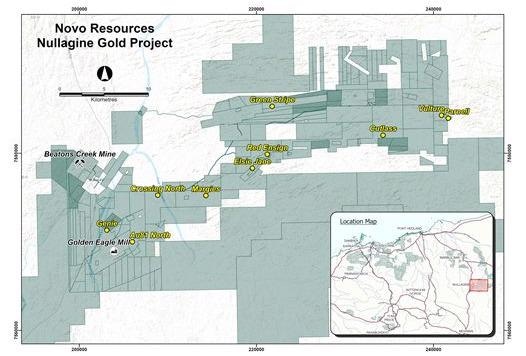Reviewed by Alex SmithNov 22 2021
Novo Resources Corp. has come up with an update regarding brownfields exploration programs at its highly prospective Nullagine gold project (NGP), where the focus is on oxide opportunities.

Location Map for NGP showing Novo tenure and priority prospects. Image Credit: Novo Resources Corp.
The Parnell-Vulture trend and Vulture reverse circulation (RC) programs form part of the ramp-up stage of the NGP exploration program, where forward programs are now being made at various priority basement targets. At the Parnell trend, the main mineralized trend is almost untested with modern RC drilling, where only a few sporadic lines of shallow holes were completed in the 1980s and 1990s.
Chase Minerals NL drilled 25 shallow RC holes in 1987, summing up to 1,098 m. Welcome Stranger Mining Company NL drilled 11 more RC holes in 1995 for 420 m. These operators targeted directly in and around small historical workings, returning grades including:
- 7 m at 6.1 g/t gold from 40 m
- 9 m at 8.4 g/t gold from 7 m
- 12 m at 14.6 g/t gold from 40 m
The results mentioned above do not necessarily represent mineralization in the entire district. The historical data was revealed in annual exploration reports filed by Welcome Stranger and Chase with the Western Australian Department of Mines, Industry Regulation and Safety’s (DMIRS). The technical information reported here has been obtained from these reports.
Novo performed elaborate gridded soil sampling and mapping to identify the mineralization potential at the Parnell and Vulture prospects. However, it has not performed an adequate study to confirm all historic data.
A series of strong, coherent gold anomalies obtained from soil sampling 2 validated targets outlined during the June mapping program, which peaked at 7.8 g/t Au. Major rock chip samples (up to 14.6 g/t Au) were also obtained from both Parnell and Vulture, again indicating the occurrence of high-grade gold targets and further validating the potential of this area.
The Parnell trend includes high-grade veins in a wide shear zone encompassing 1 to 5 m and trending nearly east–west. Two porphyry dykes featuring the best quartz veining zone intrude the south-dipping zone of shearing in the footwall of the main 6-m-wide porphyry dyke.
There is a dip in gold mineralization towards the south at steep to moderate angles. Sandstone and interbedded siltstone-sandstone sequences close to the main shear are highly bleached in the weathering profile. This points towards possible sericite alteration of the original rock, which is up to 50 m wide.
The focus of the drill targets is on the main mineralized shear zone and vein swarms to the north and south of the main shear zone.
Analytical Methodology
In the case of the next drilling program, samples will be gathered from the rig with the help of a cone splitter. The samples will be sent to Intertek Laboratory in Perth, Australia. They will be crushed to -2 mm and sent to PhotonAssay for gold analysis.